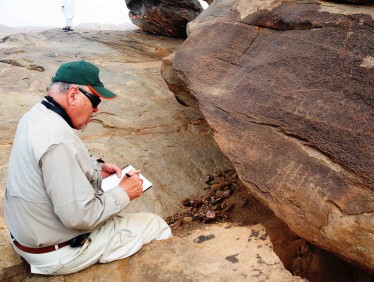UM archaeologist David Graf’s exploration of Jurash establishes the site as an important stop along the ancient pre-Islamic caravan trade route.

UM scholar David Graf, who has been surveying and excavating archaeological sites for the past 32 years, is seen here recording inscriptions found at Jurash in southwest Saudi Arabia.
Eroded by the elements and the march of time, the ruins at Jurash in southwest Saudi Arabia still held a trove of ancient artifacts just awaiting discovery. But finding them would take both time and careful excavation. An international team of archaeologists would get the first crack at it, descending upon the city in the Asir Mountains three years ago to begin excavating a site that dates back to 500 B.C.
Among the explorers was a University of Miami religious studies professor who began surveying and excavating archaeological sites some 32 years ago.
“It was an adventure. Nobody had really explored this area,” says David Graf.
A specialist in the history and archaeology of the Greco-Roman Near East, Graf led and supervised the excavation of Jurash over two five-week seasons in August 2008 and 2009, discovering artifacts that have helped confirm the city’s importance as a trading post on the ancient pre-Islamic caravan trade route that extended from Yemen and ran north to the Mediterranean Sea.

Team members clear the fort walls at Jurash. The structure probably served as the focal point of a conglomeration of buildings that made up Jurash when it was a thriving city.
“We knew the northern parts of the route pretty well,” Graf explains. “But we knew almost nothing about the southern portion.”
His team’s work would soon uncover the missing links. With military and police escorts at their sides, the team arrived at the site at the crack of dawn each day, toting trowels, pickaxes, brushes, and other tools of their trade. They used surveying equipment to map the trenches and a digital camera to document each discovery.
Among the findings: solid evidence of Yemen and South Arabian influence that ranged from small houses to pottery and inscriptions. The American and Canadian archaeologists, along with their Saudi counterparts, also found animal bone fragments and recorded about 20 ancient wells at the site, an indication that water was readily available there.
But it was the exposure of the north and east walls of a fort that was the team’s most crucial find. First described by British explorer Harry St. John Philby in his book Arabian Highlands, the structure, which is similar to forts in Yemen, probably served as the focal point of a conglomeration of buildings that made up Jurash when it was a thriving city.
Located in highlands 4,000 feet above sea level, Jurash was on an especially attractive route for caravans that transported incense, rare spices, and other goods. By passing through the city, “caravans could avoid the hot desert to the east,” Graf notes.
FATE OF THE FINDINGS
Most of the findings were bagged and tagged, with the pottery being shipped to team member Bill Glanzman, an associate professor in the Department of Sociology and Anthropology at Mount Royal University in Canada, where he is writing a report on the pieces. Graf brought back a few pieces of pottery to UM, which may come in handy for a course on pre-Islamic Arabia he will teach next fall. And arrangements are being made for a British osteologist in Cyprus to examine the many animal bone fragments.

A map of Jurash, where recovered archaeological evidence has helped fill out knowledge of the incense routes that once ran through the area.
As for the rest of the findings, they are stored in a Saudi warehouse, all digitally photographed before they were shelved.
Graf is now publishing articles on the excavation and its findings in academic journals, with one report, focusing on the team’s second season in Jurash, being submitted this summer.
The importance of the Joint Saudi-American Expedition to Jurash, as it is officially called, goes beyond its scholarly discoveries. “Saudi Arabia had been a closed shop in the sense that no one was able to excavate there, except for the people approved by the [Saudi Commission for Tourism and Antiquities],” Graf says.
Recently, however, Saudi officials have allowed American, French, German, Italian, and Japanese archaeological teams to excavate there, learning from their methods and techniques as part of an effort to explore the country’s history and open up ancient sites to tourism.
HOW IT ALL STARTED
Backed by UM’s College of Arts and Sciences, Princeton University, and Exxon-Mobile, the Jurash project was also supported by the U.S. Embassy in Riyadh after Graf had to abandon earlier plans for a joint U.S.-Saudi expedition because of the outbreak of the Iraq war. Graf now hopes it will lead to future excavations–which, he’s quick to point out, bear no resemblance to the swashbuckling escapades depicted in Hollywood movies such as the Indiana Jones franchise.

David Graf, right, consults with Gary Rollefson, a prehistorian from Whitman College, at the excavation site.
Interestingly, Graf once had dinner with series star Harrison Ford, director Steven Spielberg, and actor Sean Connery in 1988, when Spielberg was filming Indiana Jones and the Last Crusade in Jordan. The UM scholar was excavating there at the time. Surprisingly, Graf chuckles, the Hollywood trio didn’t ask him a single word of advice on the subject of archaeology.
He has also been on the set of Bad Boys II with Will Smith. “It was his wife’s [Jada Pinkett Smith’s] birthday, and he wanted an Egyptologist to talk to her,” Graf recalls.
Those are the rare moments in the limelight for Graf. In Jurash, it was all hard work, starting at seven o’clock in the morning and working well into the night processing finds.
In the end, Graf says, it all paid off: “I think we’ve put it [Jurash] on the map.”







